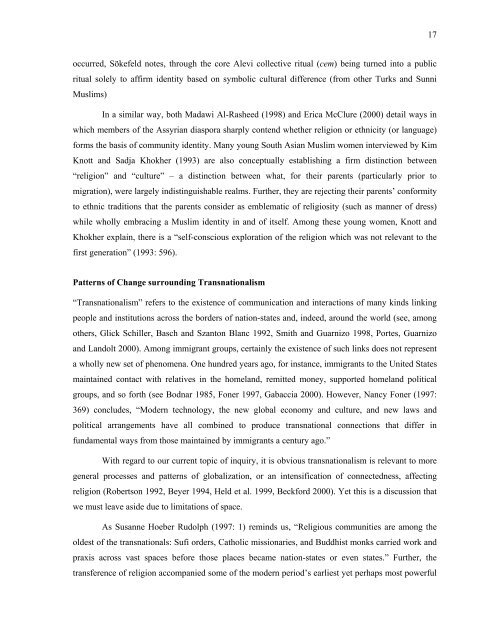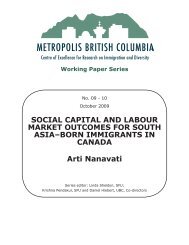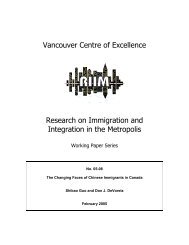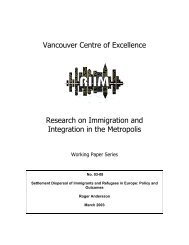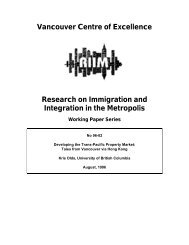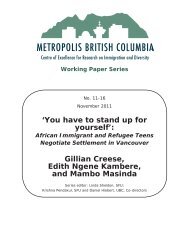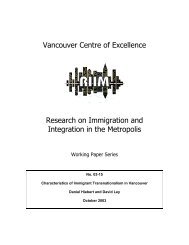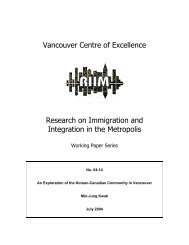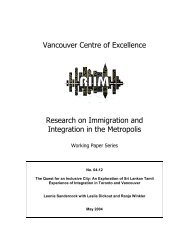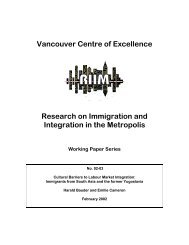Religion in Migration, Diasporas and Transnationalism - Metropolis BC
Religion in Migration, Diasporas and Transnationalism - Metropolis BC
Religion in Migration, Diasporas and Transnationalism - Metropolis BC
Create successful ePaper yourself
Turn your PDF publications into a flip-book with our unique Google optimized e-Paper software.
17<br />
occurred, Sökefeld notes, through the core Alevi collective ritual (cem) be<strong>in</strong>g turned <strong>in</strong>to a public<br />
ritual solely to affirm identity based on symbolic cultural difference (from other Turks <strong>and</strong> Sunni<br />
Muslims)<br />
In a similar way, both Madawi Al-Rasheed (1998) <strong>and</strong> Erica McClure (2000) detail ways <strong>in</strong><br />
which members of the Assyrian diaspora sharply contend whether religion or ethnicity (or language)<br />
forms the basis of community identity. Many young South Asian Muslim women <strong>in</strong>terviewed by Kim<br />
Knott <strong>and</strong> Sadja Khokher (1993) are also conceptually establish<strong>in</strong>g a firm dist<strong>in</strong>ction between<br />
“religion” <strong>and</strong> “culture” – a dist<strong>in</strong>ction between what, for their parents (particularly prior to<br />
migration), were largely <strong>in</strong>dist<strong>in</strong>guishable realms. Further, they are reject<strong>in</strong>g their parents’ conformity<br />
to ethnic traditions that the parents consider as emblematic of religiosity (such as manner of dress)<br />
while wholly embrac<strong>in</strong>g a Muslim identity <strong>in</strong> <strong>and</strong> of itself. Among these young women, Knott <strong>and</strong><br />
Khokher expla<strong>in</strong>, there is a “self-conscious exploration of the religion which was not relevant to the<br />
first generation” (1993: 596).<br />
Patterns of Change surround<strong>in</strong>g <strong>Transnationalism</strong><br />
“<strong>Transnationalism</strong>” refers to the existence of communication <strong>and</strong> <strong>in</strong>teractions of many k<strong>in</strong>ds l<strong>in</strong>k<strong>in</strong>g<br />
people <strong>and</strong> <strong>in</strong>stitutions across the borders of nation-states <strong>and</strong>, <strong>in</strong>deed, around the world (see, among<br />
others, Glick Schiller, Basch <strong>and</strong> Szanton Blanc 1992, Smith <strong>and</strong> Guarnizo 1998, Portes, Guarnizo<br />
<strong>and</strong> L<strong>and</strong>olt 2000). Among immigrant groups, certa<strong>in</strong>ly the existence of such l<strong>in</strong>ks does not represent<br />
a wholly new set of phenomena. One hundred years ago, for <strong>in</strong>stance, immigrants to the United States<br />
ma<strong>in</strong>ta<strong>in</strong>ed contact with relatives <strong>in</strong> the homel<strong>and</strong>, remitted money, supported homel<strong>and</strong> political<br />
groups, <strong>and</strong> so forth (see Bodnar 1985, Foner 1997, Gabaccia 2000). However, Nancy Foner (1997:<br />
369) concludes, “Modern technology, the new global economy <strong>and</strong> culture, <strong>and</strong> new laws <strong>and</strong><br />
political arrangements have all comb<strong>in</strong>ed to produce transnational connections that differ <strong>in</strong><br />
fundamental ways from those ma<strong>in</strong>ta<strong>in</strong>ed by immigrants a century ago.”<br />
With regard to our current topic of <strong>in</strong>quiry, it is obvious transnationalism is relevant to more<br />
general processes <strong>and</strong> patterns of globalization, or an <strong>in</strong>tensification of connectedness, affect<strong>in</strong>g<br />
religion (Robertson 1992, Beyer 1994, Held et al. 1999, Beckford 2000). Yet this is a discussion that<br />
we must leave aside due to limitations of space.<br />
As Susanne Hoeber Rudolph (1997: 1) rem<strong>in</strong>ds us, “Religious communities are among the<br />
oldest of the transnationals: Sufi orders, Catholic missionaries, <strong>and</strong> Buddhist monks carried work <strong>and</strong><br />
praxis across vast spaces before those places became nation-states or even states.” Further, the<br />
transference of religion accompanied some of the modern period’s earliest yet perhaps most powerful


